
By SEMA News Editors
Behind-the-Scenes Access to Indy's Month of May: Part 1
SEMA and PRI Associate Editor A.J. Hecht attended various racing events in and around Indianapolis throughout the month in the lead-up to the 108th Indianapolis 500. Read some of his thoughts and observations below:
Monday, May 20 – Indianapolis 500 Practice
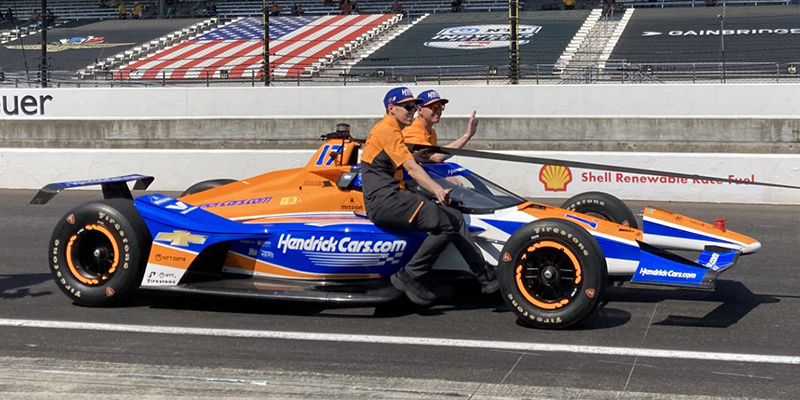
The field now set, focus turned back to race setups, and with just two, two-hour practice sessions left on the calendar, the 33 drivers and teams had little time to celebrate the successes of qualifying weekend and even less time to waste.
Every team made it on track during the penultimate session, logging a total of 2,655 laps, the most of any session so far, according to INDYCAR.
From the grandstands, the practice session looked more like a race than a testing opportunity. Long lines of cars darted down the frontstretch, weaving and drafting like there were 10 laps to go in the whole thing. If I didn't know any better, I'd think I was watching a race.
Part of what makes the 500 such a special, iconic event is the buildup, and these practice sessions are a big part of it. There aren't many races that provide anywhere near the amount of track time available to the competitors, but even with all the opportunity, it feels as if every driver, every team is pressed to make the most of each second.
While that's the case for everyone, it's doubly important for the rookies, who got their first taste of live pitstops at IMS during the Monday session. For those unfamiliar, cars dive directly onto pit lane from the exit of Turn Four during the race, a move that isn't allowed until the penultimate practice of the month. Before Monday, drivers had to enter the pits after first taking the cool-down lane, which starts on the entry to Turn Three. It's no easy task slowing the car from 220-plus mph down to 60 mph, the pit-lane speed limit, but nailing the timing can give you an advantage during the race. Miss the mark, however, and it could be a day-ender. Plenty of drivers have thrown away solid results, even race wins, on pit lane. Most drivers, even the veterans, made sure to spend some of their time perfecting their in-lap procedures. In less than a week, they'd find out if it would pay off.
Wednesday, May 22 – USAC National Sprint Car Circle City Salute
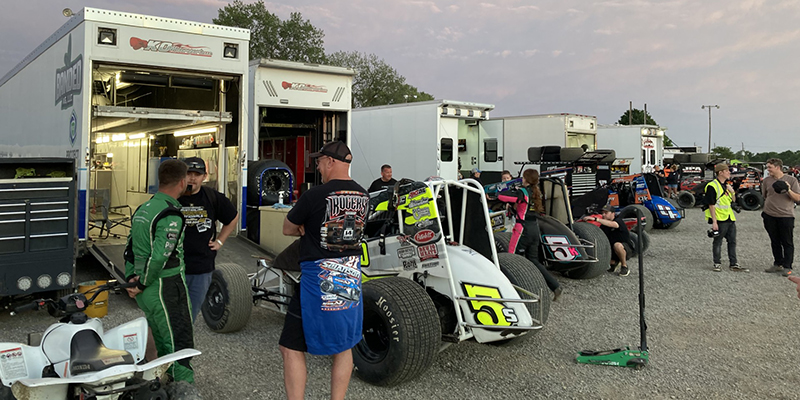
I am, admittedly, a novice when it comes to dirt track racing. Until this event, I'd never been to a dirt race, and boy, was I missing out.
Wednesday was the first of a two-night stop for the USAC Amsoil National Sprint Car series at Circle City Raceway, a quarter-mile oval on the southeast side of Indianapolis, and with late models on the undercard, I was thrown head-first into the dirt world.
At Circle City, you're very close to the action, almost on top of it, and it's easy to see what kind of car control is required to set yourself apart. Between the sound of the modulating throttle and the rapidly dancing front wheels, it's impossible to miss how much the driver is—or isn't—in control, adjusting on the fly in search of grip, the traction to get everything out of the rumbling 410ci V8. It's noticeable during hot laps, readily apparent in qualifying, and completely obvious once the heat races get going.
There was some recent online discourse about the best drivers in the world, that it couldn't be anyone "who only turns left." Those people have clearly never seen Brady Bacon, Logan Seavey, Justin Grant and the rest of their circle track competitors wheel one of these 800hp beasts around a tight, dusty oval for 30 laps.
There are exceptionally talented drivers at all levels, and in all disciplines, but it's no mystery as to why you'd find a lot of them in one of the premier sprint car circuits in the country. While great for the series and fans, it makes it difficult for some part-timers to jump in and be competitive. But that doesn't stop them from participating. One such driver entered for the two-night event, Jake Simmons, is a local, native to nearby New Palestine, Indiana, and was hopping back in the car after an extended absence from racing. Having run some USAC Sprint Car and Silver Crown races back in the day, Simmons was out supporting his local track and trying his hand at running alongside Bacon, Seavey, and the rest of the full-timers, with help from his one-man crew: his dad, Tim.
While the results weren't quite what he was hoping for, he was still happy to shake off a little rust and do his part to ensure Circle City Raceway is around for the long haul. Drivers like Simmons highlight the importance of supporting your local race track and their role in a thriving motorsports industry. That fact wasn't lost on him.
"I live 10 minutes down the road. I want this track to succeed," Simmons said. "It's critical to the local scene, and we just want to support a local track, the local people. It's important to me. I want to be able to come out here and race when I want to race."
It also affords him a very unique opportunity: to race in Indianapolis, in May, on the week of the Indianapolis 500.
"It's awesome. I love this week. You have Terre Haute, you have two nights [at Circle City Raceway], the Little 500, it's huge," Simmons said. "We're not running the 500, but it's still really cool to be able to run in a car in Indiana, let alone Indianapolis, during the month of May, the week of the 500. It's awesome."
Ultimately, Bacon came out on top and found victory lane, a seemingly popular result among the sizeable crowd. Consumed by a cloud of dust, the Broken Arrow, Oklahoma, native successfully navigated the 24-car field in the night's feature race, surviving multiple late restarts to take what I later learned was his first win of the season.
It was an enlightening experience for me. I never doubted that these drivers were skilled, that it takes as much talent to wheel a sprint car as it does anything else. But to see it up close, to see the artistry and precision required to be the best, gave me a new-found appreciation for the drivers grinding it out, week after week, night after night, on the local short tracks.
Yes, it was my first dirt-track experience, but it certainly won't be my last.
Thursday, May 23 – HMD Motorsports Shop Grand Opening
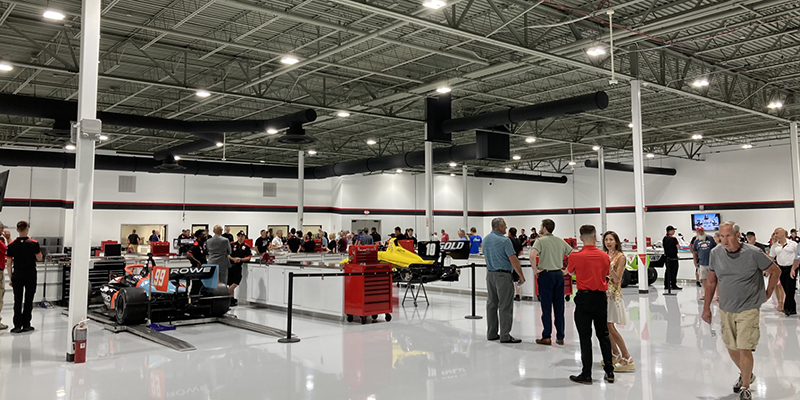
HMD Motorsports hasn't been around long, but if their new Brownsburg, Indiana, race shop is any indication, they're here to stay.
The INDY NXT team, helmed by trucking executive Henry Malukas, celebrated the long-awaited opening of its new home with an open house, signaling its intention to become a stalwart in the INDYCAR ladder and the top levels of North American motorsports.
During the open house, friends, family, and the general public filled the cavernous facility, an almost 80,000 sq. ft. building that was, in another life, a Marsh grocery store. Visitors got a chance to see the 12 bays and numerous Dallara IL-15 chassis being prepped for the next INDY NXT race, a full fleet of transporters, a sub-assembly shop, a fabrication shop, and a lot more.
A.J. Smith, HMD Motorsports team manager, originally alerted Malukas to the building's availability and was instrumental in the building's design.
"I saw the sign the day it went up and the next day we were in here with a broker," he said. Malukas then gave the go-ahead to make an offer and it snowballed from there.
"I brought my engineering team in here and we walked around and drew it out on a napkin," Smith said. "Two years in the making, but here we are."
Although fierce rivals on the track, HMD contracted Abel Construction, the company behind the Abel Motorsports INDY NXT effort, to build out the facility, which also houses a full gym, graphics department, extensive office space for more than 20 engineers, and just about everything else a 10-car effort could need.
It's so big that, as things currently stand, there are two empty bays and room for two more. "In case we ever want to go big-car racing," Smith said.
According to Team President Mike Maurini, it might not be long until they make use of that extra space, and the new shop leaves the team fully prepared for the pursuit of those lofty goals.
"Henry has aspirations to be in INDYCAR, but first we had to get a building done. We couldn't do what we wanted to do where we were, so this is the first step," Maurini said. "INDYCAR is not the sole path we can go, but we want to be involved in the top tier of motorsports in North America, whether it's sports cars or INDYCAR."
The team is also seeing immediate returns on the investment by way of personnel.
"We've met with several drivers that want to race with us next year," he said. "We brought them to the building, and it sold the whole deal."
Thursday, May 23 – Dallara and Purdue Partnership Announcement

There's little doubt that Dallara has had a tremendous impact on not only the Indianapolis 500, but the motorsports industry at large. In addition to its 20-plus wins at IMS, it has served as a supplier and constructor for numerous series around the world.
This year, it revealed a new effort that, if all goes to plan, will make a new, long-term impact on the industry. Announced just a few days before the race, Dallara has forged a new partnership with Purdue University, one of Indiana's flagship universities and the home of an extensive motorsports engineering program.
Since 2012, Dallara has maintained a permanent presence in Indianapolis, and as the new partnership indicates, one that will continue for the foreseeable future. Beginning this year, Purdue will take up residence in a portion of Dallara's Speedway, Indiana, INDYCAR Factory, making the facility the home for its Ray Ewry Sports Engineering Center.
The announcement, which will establish a direct connection between the university's engineering programs and the racing industry, coincided with the launch of another partnership—with AK Esports—expanding Dallara's place in the sim racing world.
It's encouraging, given the ever-changing world we live in, that the motorsports industry is doing its part to ensure its future, finding new ways to draw people in and showing that a career in racing is attainable, and will be for a long time to come.
Thursday, May 23 – Racing Memorabilia Show
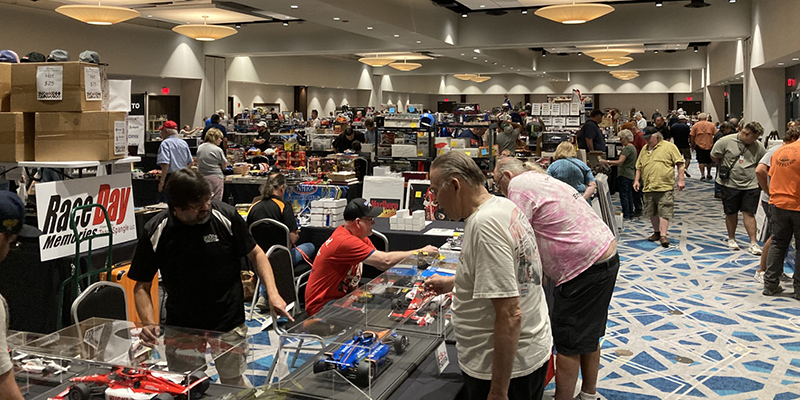
Like many involved in the racing industry, I'm a fiend for memorabilia. Programs, pins, team shirts, diecast, you name it, I probably have at least one. Every year on our trip to IMS, my dad would buy me a die-cast car, sparking a life-long obsession. I still have all of them, although a few are a little worse for wear.
As you could probably guess, the Racing Memorabilia Show, now held at an Embassy Suites in Plainfield, is always circled on my calendar.
Once held at IMS on the Saturday before the 500, the show has taken on a life of its own since organizers Kendall Wildman and Craig Huffman took over in 2021. Just three years ago, when the pair took ownership of the show, it was a two-day affair and had only 80 vendor tables.
Today, the marketplace boasts around 180 vendors, spans three days of potential shopping for collectors and is billed as the "World's Largest Racing Memorabilia Show." Although I can't verify that it's the "World's Largest," it makes a good argument.
Wildman and Huffman work year-round to plan the show, securing vendors and floorspace, coordinating guest appearances from drivers and industry legends, and gathering items for a silent auction, which benefits IndyCar Ministry, USAC RACEAID, and the American Legion. They've also formed partnerships to bring in show cars and new sponsors and hit the pavement promoting the show via word-of-mouth.
"We've put a lot of effort into building these relationships," Wildman said. "We go to multiple races every year to talk to drivers and engage with fans."
Like many others in this industry, the effort comes from a place of passion, Wildman said, who is an avid collector himself.
"It started in 2003 with a Bronze Badge," he told me, referring to the pin that grants a spectator access to Gasoline Alley, the famed IMS garage area. Then it grew to autographs and race programs.
In the following 20 years, his collection has expanded well beyond that first Bronze Badge, and now includes race suits, die-cast cars, and even a few rare items, like a pair of Dan Wheldon's race-worn gloves and an original brick from the early days of IMS.
But even for seasoned collectors like Wildman, there's still plenty to sort through at the show. And it's not just INDYCAR memorabilia. You'll find sprint and midget car die-casts, NASCAR posters, drag racing crew shirts, history books, antique tickets--you name it, you'll find it.
I did my best to keep myself in check, but still walked away with something small: a 1/64-scale Jaques Lazier Indy car. It might not have any significance to many of you, but it's the car that won the first race I ever attended, the 2001 Delphi Indy 300 at Chicagoland Speedway.
It may not seem like much, but that little car is a way for me to keep in touch with that day, a fond reminder of where this whole thing started.
Friday, May 24 – Hoosier Hundred and Carb Night Classic at Lucas Oil Indianapolis Raceway Park
I opted not to attend the Carb Day festivities at IMS on Friday--the practice, pit stop competition, and concert that kicks-off Indy 500 weekend--and instead pay a visit to the Hoosier Hundred and Carb Night Classic at Lucas Oil Indianapolis Raceway Park (IRP).
Unfortunately, the weather had other ideas, as rain washed out the evening's four-race slate. I sat in the press box for about an hour watching IRP's small but mighty crew work to dry the pavement, only for another round of showers to undo all of their hard work.
Saturday, May 25 – Hoosier Hundred and Carb "Night" Classic at Lucas Oil Indianapolis Raceway Park
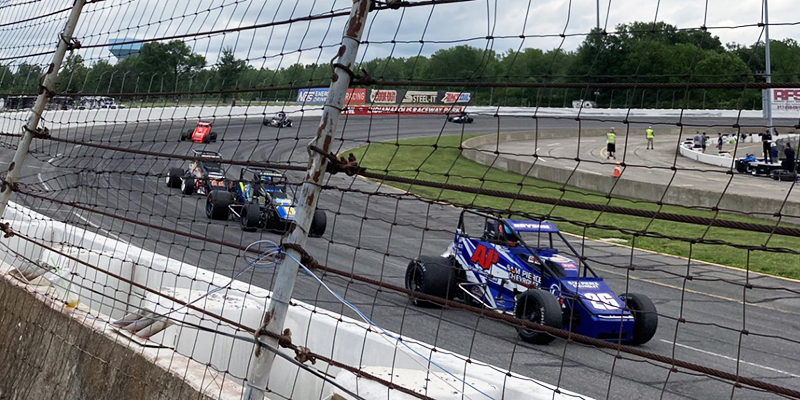
There are few things I'll set an alarm for on a Saturday morning, but racing is one of them.
Apparently, I'm not alone, because just like most of the month, Indianapolis showed up at the track bright and early, eager to see a modern take on a classic race: the USAC Silver Crown Hoosier Hundred. Forced from its historic home on the one-mile dirt oval at the Indiana State Fairgrounds, the race has moved to the pavement at IRP to carry on its 70-plus-year legacy.
It was encouraging to see such an impressive turnout for not only a delayed event but one that shines a spotlight on the two lowest rungs on the INDYCAR ladder. In addition to the headlining Silver Crown event, the docket also included some midget car action—which drew some participation from the Silver Crown field—and two races for the youngsters in the USF Pro 2000 and USF 2000 championships.
All four groups put on a show in their own way. The midget race was fast-paced and on the limit, with Jake Trainer coming out on top. During the Hoosier Hundred, Kody Swanson dominated from pole, clearing second-place Logan Seavey by 17.8 seconds. C.J. Leary, who borrowed a ride from owner/driver Bryan Gossel after engine troubles, kept things exciting with a charge from deep in the field, ultimately finishing third after lining up 22nd on the grid. He was the biggest mover at the track in two decades, according to USAC.
In the 75-lap USF 2000 race, local driver Tanner DeFabis notched his first career win, much to the excitement of the crowd and his Jay Howard Driver Development team. And to finish the morning, Braden Eves—who set the track record during Friday afternoon qualifying—fought off a stiff challenge from Jace Denmark to win the Freedom 90, the lone oval event on the USF Pro 2000 calendar.
It was stellar and compelling racing from start to finish, and as much as I love the Indy 500, will always insist upon its inclusion among the greatest sporting events in the world, it's not the only race worth watching. The Hoosier Hundred and Carb Night Classic might not have a $17-million purse or a crowd 350,000 strong, but these drivers could fool you.
If you just watch, see the way they drive, thrash at the wheel and throw their cars into the corner, use every inch of race track, fighting two- or three-wide for position, you might think there was a life-changing payday or racing immortality waiting at the finish line. There's usually not. That's what makes the Indianapolis 500 so unique, so sought after, so revered. But these races mean everything to the drivers competing in them, and that's worth just as much.
Sunday, May 26 – The 108th Running of the Indianapolis 500
After a month of buildup, the city feels like it's ready to explode. There's a communal sense of anticipation that's hard to explain to those who have never experienced it. But once you're aware of it, once you're a part of it, it's hard to escape. Waking up on race day just feels different.
Shortly after dawn, when the cannon sounds at 6 a.m. to open the track, the whole city starts to hum. It's an actual, audible hum. There are helicopters and single-prop planes buzzing overhead, endless lines of cars rolling into parking lots, whistles from traffic cops, music pumping from tailgates, the Speedway High Sparkplugs band marching toward the track. The world comes alive in a totally unique way, and every year, every single time I go back, it feels special.
No matter what, I always get goosebumps. When the pre-race traditions get going. When the Speedway falls silent for "Taps." When Jim Cornelison belts out the last notes of "Back Home Again in Indiana." When 33 cars fire up all at once. When the field charges into Turn One three abreast. When there's a race off pit road. When a driver makes a move on the outside. When the crowd roars for a late-race pass. When the white flag waves. When the leaders make the turn for home. When they charge down the front stretch for the final time.
I always, always get goosebumps. There is truly nothing else like it in the world.
I brought my now-fiancée to the race for the first time in 2018. She was immediately hooked. This year, we brought her family. Many people can attest to this, but once you bring someone to the 500, they are almost always a fan for life, can't wait to come back.
Later that night, after we survived the lengthy rain delay, held out to watch Josef Newgarden make a last lap pass for the win, and hiked back to the car just to sit in hours of traffic, they asked how to get tickets for next year.
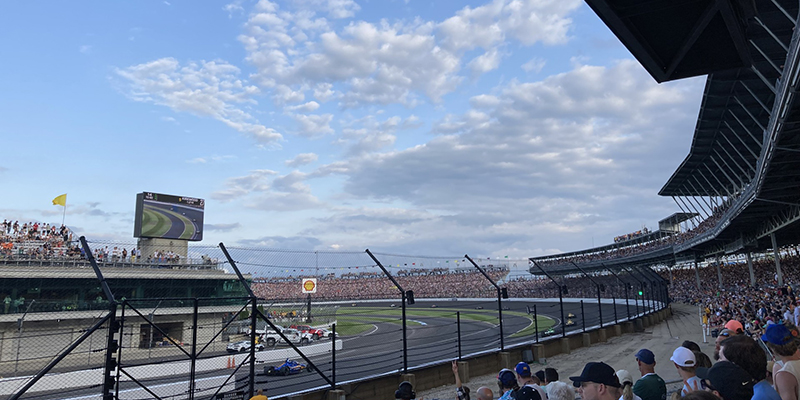
One thing I confirmed this month is that the racing world is alive and thriving, but I also discovered that it relies on one thing more than anything else. More than fuel, more than tires, more than spare parts or local race tracks, this industry relies on passion.
It was the one thing that connected every race I attended, every hand I shook and every story I heard. It was the same for everyone, whether it was Brady Bacon or Jake Simmons, Rinus Veekay or Nolan Siegel.
For many, racing is a way of life. It's not just a job or a hobby; it's a calling. You've heard that before, I'm sure, maybe even said it yourself. But to be totally immersed in this world, to see so many different sides of it in such a short time, makes clear not only how widespread that sentiment is but how powerful it is, too.
As the clock strikes "June" and I reset the countdown to my favorite month of the year, I want to first pause and say thank you to everyone at the Indianapolis Motor Speedway, INDYCAR, Firestone, USAC, Lucas Oil Indianapolis Raceway Park, the Racing Memorabilia Show, Dallara, Circle City Raceway, HMD Motorsports, and, of course, PRI, who allowed me to be a very, very small part of the Month of May.
I'll end with this:
On Pole Day, while sitting up in Stand E with my fiancée and parents, my dad turned to me and asked, "When you were here as a kid, did you ever think you'd be here with a media credential and an office down the street from the track?"
No, Dad. Not in my wildest dreams.
